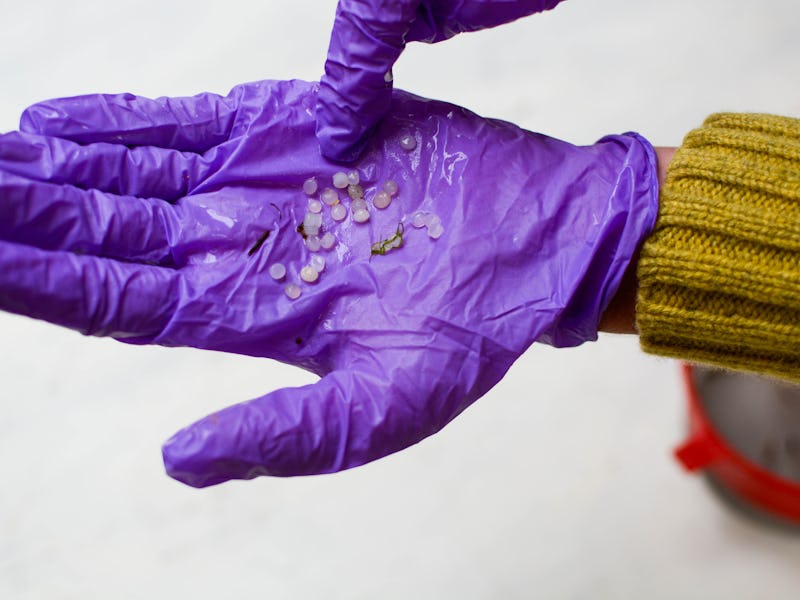The Link Between Health Problems And Microplastics Just Got A Lot Stronger
The results don’t prove any causation, but the study’s evidence is notable.

A recent study published in the prestigious New England Journal of Medicine has linked microplastics with risk to human health.
The study involved patients in Italy who had a condition called carotid artery plaque, where plaque builds up in arteries, potentially blocking blood flow. The researchers analyzed plaque specimens from these patients.
They found those with carotid artery plaque who had microplastics and nanoplastics in their plaque had a higher risk of heart attack, stroke, or death (compared with carotid artery plaque patients who didn’t have any micro- or nanoplastics detected in their plaque specimens).
Importantly, the researchers didn’t find that micro- and nanoplastics caused the higher risk, only that it was correlated with it.
So, what are we to make of the new findings? And how does it fit with the broader evidence about microplastics in our environment and our bodies?
What are microplastics?
Microplastics are plastic particles less than five millimeters across. Nanoplastics are less than one micron in size (1,000 microns is equal to one millimeter). The precise size classifications are still a matter of debate.
Microplastics and nanoplastics are created when everyday products — including clothes, food, and beverage packaging, home furnishings, plastic bags, toys, and toiletries — degrade. Many personal care products contain microplastics in the form of microbeads.
Plastic is also used widely in agriculture and can degrade over time into microplastics and nanoplastics.
These particles are made up of common polymers such as polyethylene, polypropylene, polystyrene, and polyvinyl chloride. The constituent chemical of polyvinyl chloride, vinyl chloride, is considered carcinogenic by the U.S. Environmental Protection Agency.
Of course, the actual risk of harm depends on your level of exposure. As toxicologists are fond of saying, it’s the dose that makes the poison, so we need to be careful to not over-interpret emerging research.
A closer look at the study
This new study in the New England Journal of Medicine was a small cohort, initially comprising 304 patients. However, only 257 completed the follow-up part of the study 34 months later.
The study had many limitations. The first is the findings related only to asymptomatic patients undergoing carotid endarterectomy (a procedure to remove carotid artery plaque). This means the findings might not apply to the wider population.
The authors also point out that while exposure to microplastics and nanoplastics has been likely increasing in recent decades, heart disease rates have been falling.
That said, the fact so many people in the study had detectable levels of microplastics in their bodies is notable. The researchers found detectable levels of polyethylene and polyvinyl chloride (two types of plastic) in excised carotid plaque from 58 percent and 12 percent of patients, respectively.
These patients were more likely to be younger men with diabetes or heart disease and a history of smoking. There was no substantive difference in where the patients lived.
Inflammation markers in plaque samples were more elevated in patients with detectable levels of microplastics and nanoplastics versus those without.
And then there’s the headline finding: Patients with microplastics and nanoplastics in their plaque had a higher risk of having what doctors call “a primary endpoint event” (non-fatal heart attack, non-fatal stroke, or death from any cause) than those who did not present with microplastics and nanoplastics in their plaque.
The authors of the study note their results “do not prove causality.”
However, it would be remiss not to be cautious. The history of environmental health is replete with examples of what were initially considered suspect chemicals that avoided proper regulation because of what the U.S. National Research Council refers to as the “untested-chemical assumption.” This assumption arises where there is an absence of research demonstrating adverse effects, which obviates the requirement for regulatory action.
In general, more research is required to find out whether or not microplastics cause harm to human health. Until this evidence exists, we should adopt the precautionary principle; absence of evidence should not be taken as evidence of absence.
Global and local action
Exposure to microplastics in our home, work, and outdoor environments is inevitable. Governments across the globe have started to acknowledge we must intervene.
The Global Plastics Treaty will be enacted by 175 nations in 2025. The treaty is designed, among other things, to limit microplastic exposure globally. Burdens are greatest, especially in children and especially those in low-middle income nations.
In Australia, legislation ending single-use plastics will help. So too will the increased rollout of container deposit schemes that include plastic bottles.
Microplastic pollution is an area that requires a collaborative approach between researchers, civil societies, industry, and government. We believe the formation of a “microplastics national council” would help formulate and coordinate strategies to tackle this issue.
Little things matter. Small actions by individuals can also translate to significant overall environmental and human health benefits.
Choosing natural materials, fabrics, and utensils not made of plastic and disposing of waste thoughtfully and appropriately — including recycling wherever possible — is helpful.
This article was originally published on The Conversation by Mark Patrick Taylor and Scott P. Wilson at Macquarie University. Read the original article here.